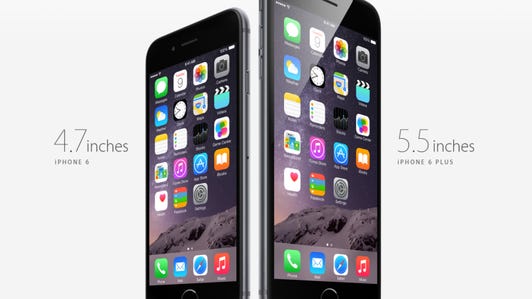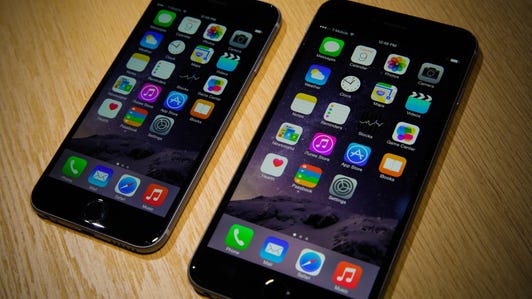
CNET
The iPhone continues to be Apple’s biggest seller. That’s both good news and bad news.
Apple’s flagship smartphone drove record sales and profits for the Cupertino, Calif., electronics maker in the final quarter of 2014. However, the heavy mix of iPhone sales again highlighted the company’s dependence on a single product line, putting it at risk down the line.
Former Apple CEO Steve Jobs long talked about his company’s strategy of having three strong products — a “three-legged stool.” Years back, it was the Macintosh computer, iPod music player and iPhone. After that, it was the iPhone, iPad and Mac. But lately, that stool has been standing on just one leg: the iPhone. That’s not a concern as long as the iPhone sells well, like it did in the holiday quarter, but one iPhone whiff and Apple’s profits could tumble.
“All I can say is: Wow, this was quite an impressive quarter,” said Michael Obuchowski, an Apple shareholder and portfolio manager at Concert Wealth Management. But “of course I am worried. Once again, we are back to the situation where iPhone…completely drives the company’s future.”
Apple’s fiscal first quarter, which ended December 27, was an absolute blowout. Its earnings, revenue and margins smashed Wall Street expectations, and it posted its highest quarter ever for Mac and App Store revenue. But the iPhone far and away drove the results.
About 69 percent of Apple’s $74.6 billion revenue came from its smartphone, far more than its typical level closer to 50 percent. iPhone sales, for example, made up 56 percent of revenue in the year-earlier period and in its fiscal fourth quarter that ended in September.
See also
- Apple rings up big holiday sales thanks to larger-screen iPhone 6
- Apple Watch to start shipping in April
- Tim Cook: 2015 will be the year of Apple Pay
- Apple’s 2015: Building on an already huge 2014
- CNET’s first take on Apple Watch
The huge bump in iPhone sales came from the company’s newest products, the 4.7-inch iPhone 6 and the 5.5-inch 6 Plus. Consumers have scooped up the devices — which sport bigger screens than 2013’s 4-inch iPhone 5S — in record numbers. Unit shipments for the smartphone jumped 46 percent to 74.5 million from the same quarter a year ago, its former record high. At the same time, revenue soared 57 percent to $51.2 billion.
“This volume is hard to comprehend,” Apple CEO Tim Cook said Tuesday during a conference call with analysts. “On average, we sold over 34,000 iPhones every hour, 24 hours a day, every day of the quarter.”
Apple’s other stool legs didn’t come anywhere near iPhone sales. The Mac business has been doing well in recent quarters, rising to its all-time highest market share and sales. But it made up only 9.3 percent of total revenue in the most recent period, down from 11 percent a year ago. And the iPad’s contribution declined for the fourth consecutive quarter, with its chunk of revenue falling to 12 percent from 20 percent a year ago.
Of course, many companies would love to be in the same position as Apple, even if it means most of their sales come from one product. And Apple will benefit from iPhone sales for a long time. The majority of people who buy an iPhone stick with the Apple ecosystem when they upgrade, and Cook noted Apple “had the highest number of customers new to iPhone last quarter than in any prior launch.”


Now playing:
Watch this:
Inside Scoop: Apple says Watch will ship in April, reports…
2:27
But Apple’s increasing reliance on the iPhone is part of what’s driven it to develop the Apple Watch. The company unveiled the device, which starts at $349, in September and said Tuesday that the smartwatch will hit store shelves in April.
“I don’t think Apple has ever felt they could put all their eggs in the iPhone basket,” said Tim Bajarin, a longtime tech analyst at firm Creative Strategies. “The reason the Apple Watch is coming is because it’s another product with growth potential.”
He estimates Apple will sell 22 million to 23 million Apple Watches in the first year. Katy Huberty, an analyst with Morgan Stanley, believes Apple will sell 30 million. That’s a good start, but neither estimate hits anywhere close to iPhone or even iPad sales. In the most recent period alone, Apple shipped 74.5 million iPhones and 21.4 million iPads.
Even if Apple Watch volumes start to rise, Apple likely won’t make as much from each device as it does from the iPhone and iPad. Bajarin estimates the average Apple Watch price will range from $449 to $549, while Apple on Tuesday said the average iPhone selling price in the first quarter was $687.
Apple isn’t relying solely on the Apple Watch as a new growth area, though. It’s also counting on Apple Pay, Beats and other new services to boost its results, and Cook has said Apple is developing new products no one has heard about yet.
“I’ve called Apple a one-device wonder in the past,” Obuchowski said. “They pulled a rabbit out of a hat at that time. I hope they can pull another one, but I am skeptical that Apple Watch will be that device. I am waiting for more new ideas.”
Until Apple’s new businesses gain traction, the company will have to hope the iPhone doesn’t slow down.
The Apple iPhone 6 and iPhone 6 Plus have arrived (pictures)






+19 more



